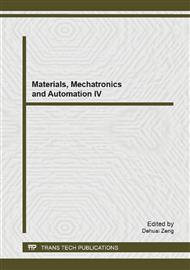[1]
M Armand, J M Tarascon. Building better batteries, Nature, London, Vol. 451, pp.652-657, February (2008).
DOI: 10.1038/451652a
Google Scholar
[2]
V. Aravindan, P. Vickraman, T. Prem Kumar. Polyvinylidene fluoride–hexafluoropropylene (PVdF–HFP)-based composite polymer electrolyte containing LiPF3(CF3CF2)3, Journal of Non-Crystalline Solids, Amsterdam, Vol. 354, p.3451–3457, April (2008).
DOI: 10.1016/j.jnoncrysol.2008.03.009
Google Scholar
[3]
Vanchiappan Aravindan, P. Vickraman. Lithium fluoro alkyl phosphate based novel composite polymer electrolytes (NCPE) incorporated with nanosized SiO2 filler, Materials Chemistry and Physics, Amsterdam, Vol. 115, p.251–257, November (2008).
DOI: 10.1016/j.matchemphys.2008.11.062
Google Scholar
[4]
C.L. Cheng, C.C. Wan, Y.Y. Wang , and M.S. Wu. Thermal shutdown behavior of PVdF-HFP based polymer electrolytes comprising heat sensitive cross-linkable oligomers, Journal of Power Sources, Amsterdam, Vol. 144, p.238–243, March (2005).
DOI: 10.1016/j.jpowsour.2004.12.043
Google Scholar
[5]
Kwang Man Kim, Jang Myoun Ko, Nam-Gyu Park, Kwang Sun Ryu, and Soon Ho Chang. Characterization of poly(vinylidenefluoride-co-hexafluoropropylene)-based polymer electrolyte filled with rutile TiO2 nanoparticles, Solid State Ionics, Amsterdam , Vol. 161, p.121–131, May (2003).
DOI: 10.1016/s0167-2738(03)00211-x
Google Scholar
[6]
Kwang Man Kim, Nam-Gyu Park, Kwang Sun Ryu, Soon Ho Chang. Characteristics of PVdF-HFP/TiO2 composite membrane electrolytes prepared by phase inversion and conventional casting methods, Electrochimica Acta, Amsterdam, Vol. 51, p.5636–5644, April (2006).
DOI: 10.1016/j.electacta.2006.02.038
Google Scholar
[7]
Ruiying Miao, Bowen Liu, Zhongzheng Zhu, Yun Liu, Jianling Li, Xindong Wang, and Qingfeng Li. PVDF-HFP-based porous polymer electrolyte membranes for lithium-ion batteries, Journal of Power Sources, Amsterdam, Vol. 184, p.420–426, March (2008).
DOI: 10.1016/j.jpowsour.2008.03.045
Google Scholar
[8]
A. Manuel Stephan, Kee Suk Nahm, M. Anbu Kulandainathan, G. Ravi, J. Wilson. Poly(vinylidene fluoride-hexafluoropropylene) (PVdF-HFP) based composite electrolytes for lithium batteries, European Polymer Journal, European Polymer Journal , Vol. 42, p.1728–1734, April (2006).
DOI: 10.1016/j.eurpolymj.2006.02.006
Google Scholar
[9]
S.K. Tripathi, Ashok Kumar, S.A. Hashmi. Electrochemical redox supercapacitors using PVdF-HFP based gel electrolytes and polypyrrole as conducting polymer electrode, Solid State Ionics, European Polymer Journal , Vol. 177, p.2979 – 2985, March (2006).
DOI: 10.1016/j.ssi.2006.03.059
Google Scholar
[10]
G. Vijayakumar, S. N. Karthick, A. R. Sathiya Priya, S. Ramalingam, and A. Subramania. Effect of nanoscale CeO2 on PVDF-HFP-based nanocomposite porous polymer electrolytes for Li-ion batteries, J Solid State Electrochem, European Polymer Journal, Vol. 12, p.1135 – 1141, November (2008).
DOI: 10.1007/s10008-007-0460-8
Google Scholar


